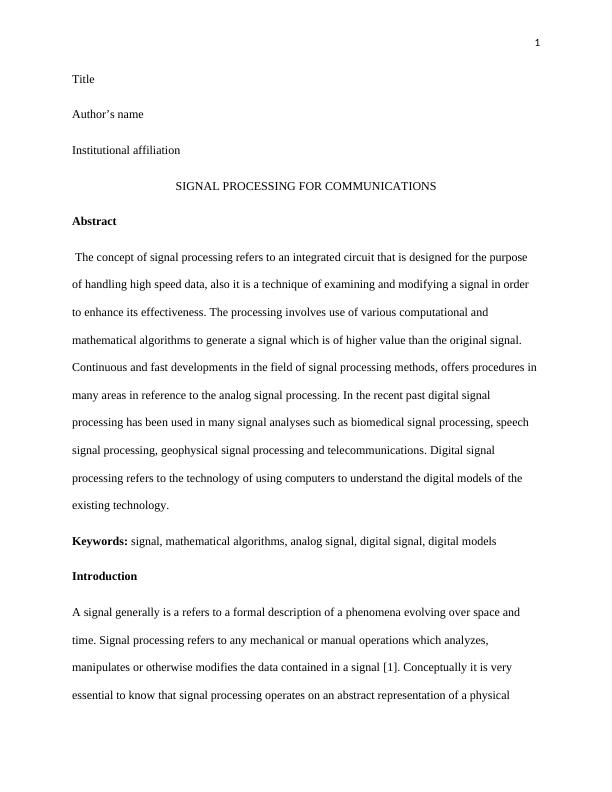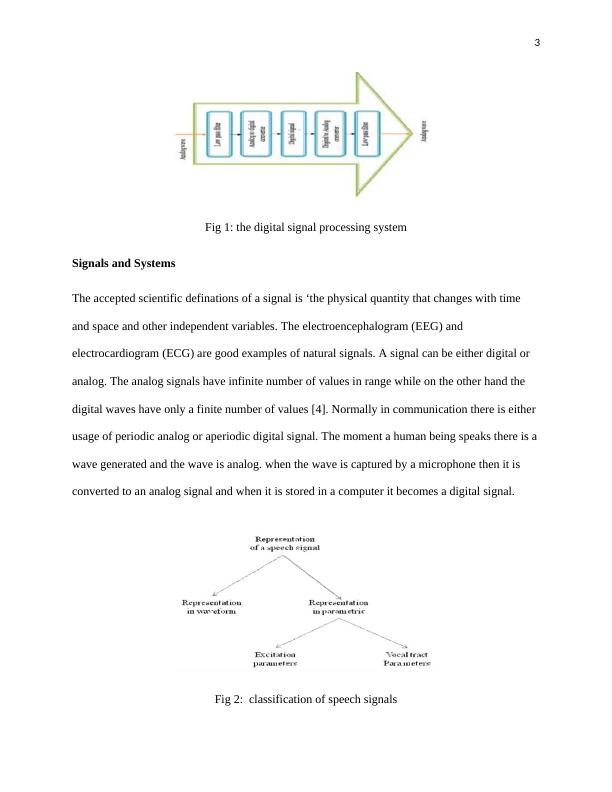Signal Processing for Communications
Added on 2023-06-05
7 Pages1736 Words426 Views
1
Title
Author’s name
Institutional affiliation
SIGNAL PROCESSING FOR COMMUNICATIONS
Abstract
The concept of signal processing refers to an integrated circuit that is designed for the purpose
of handling high speed data, also it is a technique of examining and modifying a signal in order
to enhance its effectiveness. The processing involves use of various computational and
mathematical algorithms to generate a signal which is of higher value than the original signal.
Continuous and fast developments in the field of signal processing methods, offers procedures in
many areas in reference to the analog signal processing. In the recent past digital signal
processing has been used in many signal analyses such as biomedical signal processing, speech
signal processing, geophysical signal processing and telecommunications. Digital signal
processing refers to the technology of using computers to understand the digital models of the
existing technology.
Keywords: signal, mathematical algorithms, analog signal, digital signal, digital models
Introduction
A signal generally is a refers to a formal description of a phenomena evolving over space and
time. Signal processing refers to any mechanical or manual operations which analyzes,
manipulates or otherwise modifies the data contained in a signal [1]. Conceptually it is very
essential to know that signal processing operates on an abstract representation of a physical
Title
Author’s name
Institutional affiliation
SIGNAL PROCESSING FOR COMMUNICATIONS
Abstract
The concept of signal processing refers to an integrated circuit that is designed for the purpose
of handling high speed data, also it is a technique of examining and modifying a signal in order
to enhance its effectiveness. The processing involves use of various computational and
mathematical algorithms to generate a signal which is of higher value than the original signal.
Continuous and fast developments in the field of signal processing methods, offers procedures in
many areas in reference to the analog signal processing. In the recent past digital signal
processing has been used in many signal analyses such as biomedical signal processing, speech
signal processing, geophysical signal processing and telecommunications. Digital signal
processing refers to the technology of using computers to understand the digital models of the
existing technology.
Keywords: signal, mathematical algorithms, analog signal, digital signal, digital models
Introduction
A signal generally is a refers to a formal description of a phenomena evolving over space and
time. Signal processing refers to any mechanical or manual operations which analyzes,
manipulates or otherwise modifies the data contained in a signal [1]. Conceptually it is very
essential to know that signal processing operates on an abstract representation of a physical

2
quantity and not he quantity itself. The field of signal processing in communication has grown at
an alarming rate due to the affordability and availability of digital computers in implementing
signal processing algorithms. The signal processing in communication has broadened into the
application of various technologies both analog and digital. The earliest ever recorded example
for digital processing dates back to 25th century BC.
1960s is well known as the uprising year for the Digital signal processing as it led to
development of space exploration, sonar and radar. Signal processing has been used for
implementations in many other fields which uses it and have developed technology with their
specialized techniques, specific algorithms and their arithmetic [2]. The Digital signal processing
enhances the reliability and accuracy in the field of digital communication. Normally digital
signal processing first converts an analog signal into a digital signal and then be relevant signal
processing technique and algorithms, at the same time it helps to reduce distortion and noise. The
fundamental of digital signal processing is that it works by standardizing the levels of a given
signal. All the communication channels have some background noise whether the signals are
digital or analog, and apart from which type of data is being transferred. This noise in reference
to some signal is referred to as signal to noise ratio for communication systems, usually one tries
to determine how it enhances. Suppose an incoming analog signal like that of a television
broadcast station, the signal is usually converted to digital fist by use of analog-to-digital
converter and the resulting digital signal has either two or more levels., usually this levels are
knowable. Because the incoming analog signal contains noise hence many times the levels are
not at typical values., with that the digital signal processing correct the values of levels and
remove the noise. And he resulting digital signal is changed back o analog by using the digital-
to-analog converter [3]. The block diagram below shows the digital signal processing system.
quantity and not he quantity itself. The field of signal processing in communication has grown at
an alarming rate due to the affordability and availability of digital computers in implementing
signal processing algorithms. The signal processing in communication has broadened into the
application of various technologies both analog and digital. The earliest ever recorded example
for digital processing dates back to 25th century BC.
1960s is well known as the uprising year for the Digital signal processing as it led to
development of space exploration, sonar and radar. Signal processing has been used for
implementations in many other fields which uses it and have developed technology with their
specialized techniques, specific algorithms and their arithmetic [2]. The Digital signal processing
enhances the reliability and accuracy in the field of digital communication. Normally digital
signal processing first converts an analog signal into a digital signal and then be relevant signal
processing technique and algorithms, at the same time it helps to reduce distortion and noise. The
fundamental of digital signal processing is that it works by standardizing the levels of a given
signal. All the communication channels have some background noise whether the signals are
digital or analog, and apart from which type of data is being transferred. This noise in reference
to some signal is referred to as signal to noise ratio for communication systems, usually one tries
to determine how it enhances. Suppose an incoming analog signal like that of a television
broadcast station, the signal is usually converted to digital fist by use of analog-to-digital
converter and the resulting digital signal has either two or more levels., usually this levels are
knowable. Because the incoming analog signal contains noise hence many times the levels are
not at typical values., with that the digital signal processing correct the values of levels and
remove the noise. And he resulting digital signal is changed back o analog by using the digital-
to-analog converter [3]. The block diagram below shows the digital signal processing system.

3
Fig 1: the digital signal processing system
Signals and Systems
The accepted scientific definations of a signal is ‘the physical quantity that changes with time
and space and other independent variables. The electroencephalogram (EEG) and
electrocardiogram (ECG) are good examples of natural signals. A signal can be either digital or
analog. The analog signals have infinite number of values in range while on the other hand the
digital waves have only a finite number of values [4]. Normally in communication there is either
usage of periodic analog or aperiodic digital signal. The moment a human being speaks there is a
wave generated and the wave is analog. when the wave is captured by a microphone then it is
converted to an analog signal and when it is stored in a computer it becomes a digital signal.
Fig 2: classification of speech signals
Fig 1: the digital signal processing system
Signals and Systems
The accepted scientific definations of a signal is ‘the physical quantity that changes with time
and space and other independent variables. The electroencephalogram (EEG) and
electrocardiogram (ECG) are good examples of natural signals. A signal can be either digital or
analog. The analog signals have infinite number of values in range while on the other hand the
digital waves have only a finite number of values [4]. Normally in communication there is either
usage of periodic analog or aperiodic digital signal. The moment a human being speaks there is a
wave generated and the wave is analog. when the wave is captured by a microphone then it is
converted to an analog signal and when it is stored in a computer it becomes a digital signal.
Fig 2: classification of speech signals

End of preview
Want to access all the pages? Upload your documents or become a member.
Related Documents
Compute Network And Security Analysislg...
|22
|3456
|9
CI7110 Data Communicationslg...
|20
|5810
|175
Wireless Networks and Communication Name of Student Institution Affiliation Question 1: Converting Binary Data into Analog Waveformslg...
|28
|1093
|200
Analogue to Digital Converterlg...
|4
|507
|368
This theory was developed by Alexandrelg...
|13
|3092
|18
Direct Digital synthesis (DDS)lg...
|5
|1496
|430
